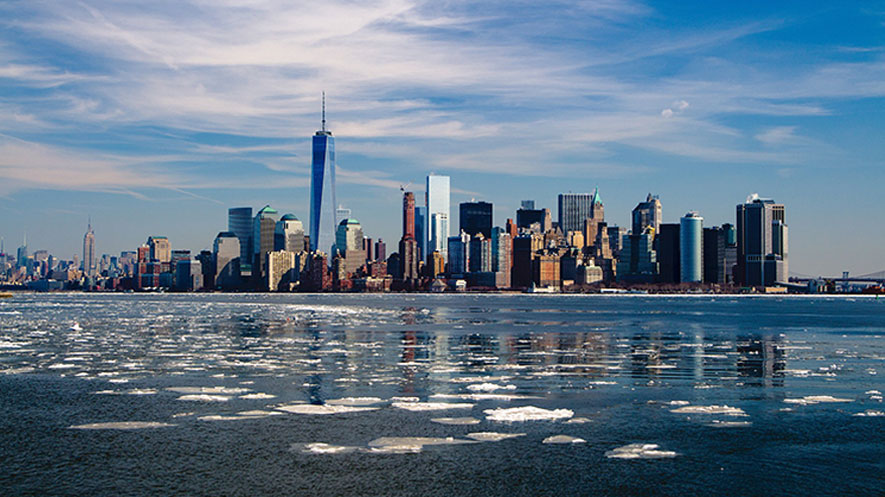On April 17, the Mid-Atlantic Regional Council on the Ocean (MARCO) released a first-of-its-kind report at the Mid-Atlantic scale that examines the vulnerabilities of several critical economic sectors to climate change.
A new report quantifies the potential impacts of threats like sea level rise, rising ocean temperatures, and changes in the ocean’s chemistry to communities and businesses in 63 counties and independent cities along the coast from New York to Virginia.
The challenges are especially pronounced in the Mid-Atlantic, the most densely populated stretch of coastline in the country. The region’s waterfront is home to America’s largest city, New York; two of its busiest ports in New York/New Jersey and Hampton Roads, Virginia; and iconic beach destinations that have entertained summer tourists for generations.
The analysis considered the ramifications of both temporary flooding events and the permanent inundation of some areas that would occur if sea levels were to rise by 3 or 6 feet by 2100 – two scenarios that are commonly assumed by planners throughout the region. Among the findings:
- Approximately 14.6 million people live in Census tracts adjacent to the ocean, Chesapeake or Delaware Bays. In the 3-foot scenario, the resulting flooded area could affect 1.7 million people and in the 6-foot scenario, 2.1 million people.
- Today, 912,000 housing units would be vulnerable to flooding in the 3-foot scenario and 1.1 million in the 6-foot scenario. These include 212,000 seasonal units in the 3-foot scenario and 248,000 in the 6-foot scenario.
- Approximately 557,000 jobs would be vulnerable in the 3-foot scenario and 974,000 in the 6-foot scenario.
In the 3-foot scenario, Delaware has the highest average vulnerability, followed by the counties or cities of Maryland, New Jersey, Virginia, New York, and Pennsylvania. At 6 feet, New York has the highest average vulnerability followed by Virginia, Pennsylvania, New Jersey, Delaware, and Maryland. The region’s major urban centers’ vulnerability to severe disruption increases significantly if sea level rises more than 3 feet.
“No community or business in the Mid-Atlantic will be spared from the impacts of climate change,” said lead author Charles Colgan of the Center for the Blue Economy of the Middlebury Institute of International Studies at Monterey, California. “This is not simply a threat to waterfront areas. With everything from jobs to the housing market being tightly bound to ocean-dependent industries, every coastal community, whether beachfront or further inland, has some vulnerability.”
Significant and perhaps rapid shifts in habitat brought about by climate change will challenge commercial fishing and government agencies to move quickly to adapt fishing practices and management policies. From Maine to North Carolina, a 25% loss of catch is possible for species affected by climate change, which would translate to a 20% decline in annual value.
The report offers guidance on some strategies that are effectively being employed throughout the Mid-Atlantic to adapt to climate change. For example, the report suggests governments at all levels can follow the model provided by the region’s ports, which are considering climate change in their designs as they rehabilitate or replace infrastructure. Natural defenses such as the restoration of wetlands and marsh grasses were identified as cost-effective means for addressing the threats of retreating shorelines and encroachments from coastal development.
“Natural infrastructure reduced coastal property damages by $650 million during Superstorm Sandy,” Colgan said. “In many cases, even local governments and NGOs can begin taking on these nature-based projects without the need for major grant support or government intervention.”
The report, “Climate Change Vulnerabilities in the Coastal Mid-Atlantic Region,” was prepared as part of the MARCO-led “Planning for a Changing Ocean” project, which aimed to better understand how a changing climate impacts our ocean and the Mid-Atlantic’s diverse marine ecosystems, coastal communities, and economies. The project examined the implications for the resilience of current trends including increased acidification of coastal and ocean waters, the availability of offshore sand resources, and shifting marine life habitats habitats. The effort was a collaboration of MARCO and the Monmouth University Urban Coast Institute, made possible by a grant from the National Oceanic and Atmospheric Administration.



